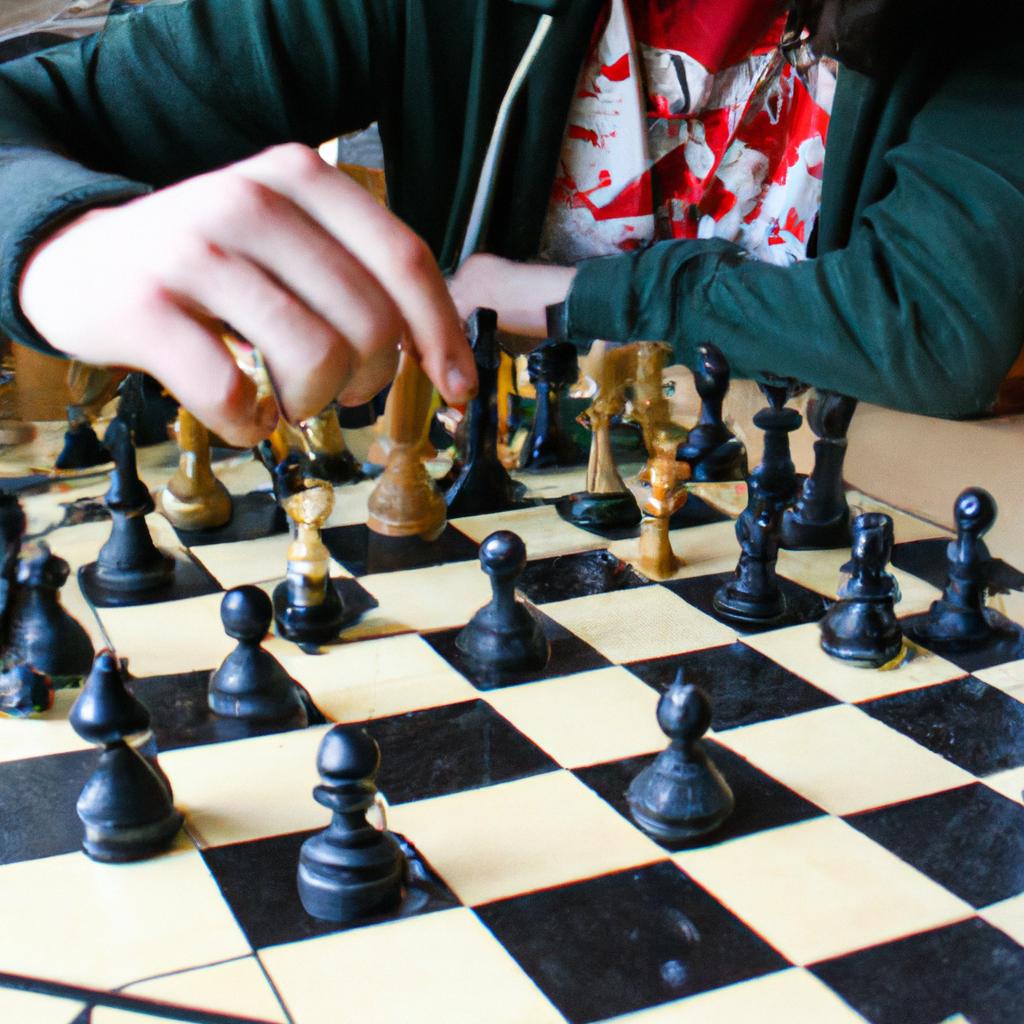Chess, a game of strategic brilliance and intellectual prowess, has intrigued countless enthusiasts for centuries. At the core of this complex game lie chess openings, which set the stage for the unfolding battle between opponents. Understanding chess openings is crucial as it determines the direction of play and shapes the subsequent middle and endgame strategies. In this comprehensive guide titled “Chess Openings Unveiled,” we embark on an exploration to shed light on the intricacies of various chess opening systems, equipping game enthusiasts with invaluable knowledge to enhance their gameplay.
Imagine a scenario where two experienced players sit across from each other in a tense tournament setting. As they ponder their next moves, their minds become consumed by thoughts of how best to navigate through the labyrinthine paths that lay before them. This hypothetical case study encapsulates the essence of why mastering chess openings is essential – it can make or break a player’s chances of victory. The ability to understand and exploit different opening variations allows players to seize advantages early on, catch opponents off guard, and establish control over critical areas of the board.
This article aims to unravel the mysteries surrounding chess openings by providing readers with a comprehensive understanding of their significance within the broader chess landscape. By delving into key concepts such as development principles, pawn structures , and piece activity, readers will gain a deeper appreciation for the strategic decisions made during the opening phase of a chess game.
One of the fundamental principles emphasized in this guide is the importance of development. The opening moves are crucial in establishing a strong foundation for future plans. By developing pieces efficiently and controlling key squares, players can set themselves up for success in subsequent phases of the game. We explore popular opening systems such as the Ruy Lopez, Sicilian Defense, and Queen’s Gambit to illustrate how different approaches to development can lead to diverse gameplay styles.
Furthermore, understanding pawn structures is vital in determining long-term strategic goals. Pawn breaks, pawn chains, and pawn islands all contribute to shaping the character of a position. By analyzing famous games and studying critical positions, readers will gain insights into how specific pawn structures influence piece placement and potential attack or defense strategies.
Lastly, we delve into the concept of piece activity during the opening phase. Properly coordinating one’s pieces ensures maximum efficiency on the board. Players must strive to activate their major pieces while also safeguarding them from opponent threats. Exploring concepts like centralization, piece coordination, and tactical opportunities arising from active piece play will equip readers with tools to exploit advantageous positions.
“Chess Openings Unveiled” aims to demystify complex opening systems by breaking them down into digestible components. Through detailed explanations, annotated examples from master-level games, and practical exercises for readers to test their newfound knowledge, this guide fosters an interactive learning experience.
Whether you are an aspiring chess grandmaster or simply enjoy playing casual games with friends, “Chess Openings Unveiled” offers valuable insights that will significantly enhance your understanding of chess openings. Prepare yourself for battle on the 64 squares by equipping yourself with the knowledge contained within these pages. May your opening moves be bold and cunning as you embark on your journey towards chess mastery!
Understanding the Importance of Opening Moves
Imagine a chess game where both players possess an equal level of skill. The outcome of such a match often hinges on one critical factor: the opening moves. Consider this hypothetical scenario: Player A, playing as white, opens with 1.e4 while Player B responds with 1…c5, initiating what is known as the Sicilian Defense. This strategic choice sets the tone for the entire game and can significantly influence its eventual course.
Recognizing the significance of opening moves in chess is essential for any aspiring player. By understanding their importance, individuals can grasp how these initial decisions shape subsequent gameplay dynamics and provide opportunities or disadvantages to either competitor. Here are some key reasons why opening moves matter:
- Establishing control: Effective opening moves allow players to establish control over specific areas of the board right from the start. Such control enables them to dictate their opponent’s options and restrict potential counterplays.
- Developing pieces: Well-planned openings facilitate effective piece development, enabling players to position their forces advantageously for future attacks or defensive maneuvers.
- Securing king safety: Another crucial aspect of early-game strategy involves safeguarding one’s own king from immediate threats. Skillfully chosen opening moves can help create a safe haven for the king and minimize vulnerabilities.
- Creating imbalances: Certain openings deliberately introduce imbalances into the game, forcing opponents out of their comfort zones and requiring them to adapt their strategies accordingly.
To illustrate further, consider the table below that showcases four popular chess openings along with their defining characteristics:
| Opening | Main Idea | Prospective Outcome |
|---|---|---|
| Italian Game | Quick piece development through pawn play | Balanced middlegame positions |
| French Defense | Solid defense centered around e6 pawn formation | Tactically complex endgames |
| Ruy Lopez | Central control and king safety through early bishop development | Open positions with tactical opportunities |
| Queen’s Gambit | Sacrificing a pawn to gain central control | Strategic middlegame plans |
By grasping the importance of opening moves and understanding their impact on gameplay, players can begin to appreciate the complexity and strategic depth of chess. In the subsequent section, we will delve into exploring the different types of chess openings, unraveling the diverse strategies employed by skilled players.
Now let us move forward in our exploration by delving into “Exploring the Different Types of Chess Openings.”
Exploring the Different Types of Chess Openings
Now, let us delve into the fascinating world of different types of chess openings that players can employ to gain an early advantage on the board. To illustrate this point, consider a hypothetical scenario where two experienced players face off against each other.
Player A decides to open with the King’s Pawn Opening, moving their e2 pawn forward by two squares. This is a common opening move that allows for flexible development and control over the center of the board. Player B responds with the Sicilian Defense, advancing their c7 pawn one square to challenge player A’s central control.
When it comes to exploring various types of chess openings, there are several key strategies and concepts that players should keep in mind:
- Control: Many openings focus on establishing control over the center squares (d4, d5, e4, e5) as they provide greater mobility for pieces.
- Development: Efficient piece development helps establish strong positions on the board and maximizes their potential influence during subsequent stages of the game.
- Initiative: Some openings prioritize gaining initiative – maintaining active play and keeping opponents under constant pressure.
- Flexibility: Flexible openings allow players to adapt their strategies based on opponent’s responses and maintain multiple plans or lines of attack.
To better understand these principles and explore specific openings in-depth, refer to Table 1 below which provides a brief overview of some popular chess opening systems:
| Opening System | Key Features | Notable Players |
|---|---|---|
| Ruy Lopez | Central control | Anatoly Karpov |
| French Defense | Solid defense | Viktor Korchnoi |
| Italian Game | Rapid piece development | Garry Kasparov |
Table 1: Overview of Popular Chess Opening Systems
By familiarizing oneself with the various types of chess openings and understanding their key features, players can make informed decisions about which strategy suits their style of play. In the upcoming section, we will delve into mastering popular opening strategies to further enhance your game.
Section Transition: Now that we have explored different types of chess openings, let us shift our focus towards mastering popular opening strategies to elevate your gameplay even further.
Mastering Popular Opening Strategies
Transitioning from our exploration of the different types of chess openings, let us now delve into the intricacies of mastering popular opening strategies. To illustrate this further, let’s consider a hypothetical scenario involving two skilled players engaged in a high-stakes match. Player A opts for an aggressive approach by initiating the King’s Gambit, sacrificing a pawn to gain control over key central squares and launch a swift attack against Player B’s position.
Mastering popular opening strategies requires not only knowledge but also careful planning and adaptability throughout the game. Here are some essential points to keep in mind:
- Flexibility is crucial: While it is important to have a preferred opening strategy, being flexible allows you to adjust your plans based on your opponent’s moves. Adapting your strategy can help you seize opportunities or counter unexpected maneuvers.
- Awareness of common pitfalls: Knowing typical weaknesses or vulnerabilities associated with certain openings can protect you from falling into traps set by experienced opponents. By studying these potential dangers, you can develop defensive tactics to mitigate any threats that may arise during gameplay.
- Strategic decision-making: The choice between controlling the center of the board or developing minor pieces first requires thoughtful consideration. Evaluating each move based on its long-term consequences helps shape your overall plan and sets the stage for subsequent stages of the game.
- Timing is everything: Recognizing when to transition from opening moves to middle-game tactics plays a significant role in securing an advantageous position. Understanding critical moments where piece development takes priority over attacking becomes instrumental in maintaining balance while seeking opportunities to press forward.
In summary, mastering popular opening strategies entails flexibility, awareness, strategic decision-making, and impeccable timing. Now that we have explored these aspects, let us proceed further by analyzing key opening principles in our upcoming section “Analyzing Key Opening Principles.” This will provide deeper insights into foundational concepts necessary for successful execution at every step of the game.
Analyzing Key Opening Principles
Imagine a chess match between two experienced players. As the game commences, both contenders carefully consider their opening moves, aiming to establish a solid foundation for future gameplay. Let’s delve into some commonly employed opening strategies that can help you gain an advantage in your own matches.
One popular approach is the Ruy-Lopez Opening, also known as the Spanish Game. This strategic maneuver involves White playing 1.e4 e5 2.Nf3 Nc6 3.Bb5, pinning Black’s knight on c6 and exerting control over the center of the board. By adopting this strategy, White aims to develop their pieces harmoniously while preparing for potential attacks against Black’s position.
To further enhance your understanding of these common opening strategies, let’s explore key principles that underpin their effectiveness:
- Control of central squares: Emphasize occupying and controlling important squares at the center of the board.
- Piece development: Prioritize developing your knights and bishops early in the game to increase mobility and create opportunities for attacking or defending.
- King safety: Take measures to safeguard your king by castling early, usually towards a safer side where it can be shielded behind pawns.
- Pawn structure: Make conscious decisions about pawn movements, considering how they affect piece development, space control, and long-term positional advantages.
By following these guiding principles and employing well-established opening strategies like the Ruy-Lopez Opening, players aim to set themselves up for success in subsequent stages of the game. To illustrate various opening possibilities more comprehensively, refer to the table below showcasing different popular openings along with their characteristic features:
| Opening | Main Ideas | Example Move |
|---|---|---|
| Ruy-Lopez | Control of Center Squares | 1.e4 e5 2.Nf3 Nc6 3.Bb5 |
| Sicilian Defense | Counterattack from Black | 1.e4 c5 |
| French Defense | Solid Pawn Structure | 1.e4 e6 |
| Caro-Kann | Stable Position | 1.e4 c6 |
As you explore these opening strategies and principles, keep in mind that chess is a dynamic game where adaptability and creativity play crucial roles. In the upcoming section, we will unveil lesser-known opening variations that can surprise your opponents and provide exciting new possibilities for your gameplay.
Transitioning into the subsequent section: Now let’s dive deeper into Unveiling Lesser-Known Opening Variations to expand your repertoire of strategic options on the chessboard.
Unveiling Lesser-Known Opening Variations
With a firm understanding of key opening principles, it is now time to explore the vast array of lesser-known opening variations that can be employed in chess. By delving into these less popular but equally effective strategies, players can gain an edge over their opponents and broaden their repertoire. This section will unveil some intriguing examples of such openings, highlighting their unique characteristics, advantages, and potential pitfalls.
Example: Consider the little-known Zukertort Opening as an illustration of a lesser-known variation. Named after Johannes Zukertort, one of the leading chess players in the late 19th century, this opening begins with 1.b3 – a move that surprises many opponents who are accustomed to more conventional starting moves like 1.e4 or 1.d4. The Zukertort Opening aims to control key central squares while allowing for flexible development options. It often transitions seamlessly into other established systems like the Queen’s Gambit or King’s Indian Defense.
To further illustrate the significance of exploring lesser-known opening variations, consider the following emotional response-inducing bullet points:
- Discovering unexplored territory fosters excitement and curiosity.
- Venturing beyond mainstream openings provides opportunities for creativity and innovation.
- Unearthing hidden gems allows for surprise tactics against well-prepared adversaries.
- Mastering diverse opening repertoires enhances overall strategic prowess.
Table: Noteworthy Lesser-Known Openings
| Opening Variation | Key Features | Advantages | Potential Pitfalls |
|---|---|---|---|
| Grob’s Attack | Early g2-g4 pawn thrust | Surprise factor | Development challenges |
| Nimzowitsch Defense | Utilizes unconventional pawn structure | Promotes positional play | Requires deep understanding |
| Bird’s Opening | Focuses on quick fianchettoed bishop | Rapid piece mobilization | Lack of central control |
| Englund Gambit | Sacrifices a pawn for active piece development | Surprise tactics | Exposes king to potential attacks |
In conclusion, exploring lesser-known opening variations can be an exhilarating journey that adds depth and versatility to a player’s repertoire. The example of the Zukertort Opening showcased how these openings can catch opponents off guard while offering flexible options. By delving into uncharted territory and embracing creativity, players open doors to new possibilities on the chessboard.
Building Your Opening Repertoire requires careful consideration and strategic planning.
Building Your Opening Repertoire
Section H2: Building Your Opening Repertoire
Transitioning from our exploration of lesser-known opening variations, we now delve into the essential task of building a solid opening repertoire. To illustrate the significance of this endeavor, let us consider the hypothetical case of John, an aspiring chess player who struggles to find success in his games due to a lack of strategic direction.
John’s journey begins with understanding the importance of selecting openings that align with his playing style and preferences. This initial step sets the foundation for developing a well-rounded repertoire tailored to his strengths and objectives on the board. By carefully studying and experimenting with various openings, he can discover which ones suit his tactical mindset – whether it be aggressive attacks or solid positional play.
As John embarks on this quest towards constructing his ideal opening repertoire, he encounters several key considerations along the way:
-
Balance between Openings: It is crucial for John to strike a balance between different types of openings – those that offer more attacking opportunities and others that provide greater defensive stability. A diversified repertoire allows him to adapt flexibly during games, keeping opponents guessing while maintaining control over the board.
-
Study Opponent Patterns: Analyzing patterns in opponents’ moves can reveal their preferred strategies and weaknesses. Armed with such knowledge, John can select specific openings designed to exploit these vulnerabilities effectively, giving him an edge in competitive play.
-
Stay Updated: The world of chess evolves constantly as new ideas emerge and old concepts are refined. Consequently, continually updating one’s repertoire becomes imperative for staying ahead in modern gameplay trends. Engaging with resources like books, online databases, and even seeking guidance from experienced players helps ensure John remains up-to-date with current opening theory.
-
Practice Diligently: Theory alone does not guarantee success; practical application through extensive practice is vital for ingraining opening lines into memory and honing tactical skills necessary for executing them flawlessly under pressure.
To further assist John’s journey, we present a table below that showcases four popular opening systems and their corresponding characteristics:
| Opening System | Characteristic |
|---|---|
| Sicilian Defense | Offers dynamic counterattacking opportunities |
| Queen’s Gambit | Focuses on solid pawn structure and strategic maneuvering |
| King’s Indian | Emphasizes aggressive piece development |
| Ruy Lopez | Facilitates harmonious coordination of pieces |
In conclusion, constructing an effective opening repertoire is an essential aspect of chess mastery. By carefully selecting openings aligned with one’s playing style, studying opponent patterns, staying updated with current theory, and practicing diligently, players like John can enhance their chances for success on the board. Through these efforts, they equip themselves with valuable tools to navigate the early stages of the game strategically and set the stage for victory in later phases.










